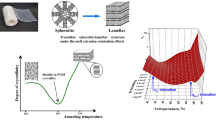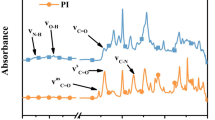Abstract
We have used various techniques such as X-ray diffraction, Fourier transform infrared spectroscopy as well as dielectric measurements with a 4 GHz Microwave resonator to investigate the structure of uniaxially drawn α-polyamide 6 films. The influence of uniaxial drawing on several parameters such as degree of crystallinity, orientation and size of crystallites, permittivity and anisotropy was studied as a function of the drawing ratio. The main axis (b-axis) of the polyamide 6 nano-crystals is aligned in the direction of drawing, while the hydrogen bonds (a-axis) are oriented transverse to the drawing direction. Increasing the drawing ratio yields a higher crystallinity, a better orientation of the crystallites, and a stronger dielectric anisotropy of the films. The good agreement of the results demonstrates that all the three experimental techniques are well suited to characterize the microstructure of polyamide films.














Similar content being viewed by others
References
Vasanthan N (2003) Orientation and structure development in polyamide 6 fibers upon drawing. J Polym Sci B 41:2870–2877
Beltrame P, Citterio C, Testa G, Seves A (1999) Oxygen permeation through films of compatibilized polypropylene/polyamide 6 blends. J Appl Polym Sci 74:1941–1949
Santamaría P, Eguiazabal J (2013) Films on amorphous polyamide nanocomposites: structure and properties. Polym Adv Technol 24:300–306
Li Y, Goddard W (2002) Nylon 6 crystal structures, folds, and lamellae from theory. Macromolecules 35:8440–8455
Hatfield GR, Glans JH, Hammond WB (1990) Characterization of structure and morphology in nylon 6 by solid-state carbon-13 and nitrogen-15 NMR. Macromolecules 23:1654–1658
Jarrar R, Mohsin M, Haik Y (2012) Alteration of the mechanical and thermal properties of nylon 6/nylon 6.6 blends by nanoclay. J Appl Polym Sci 124:1880–1890
Stepaniak RF, Garton A, Carlsson DJ, Wiles DM (1979) The characterization of nylon 6 filaments by X-ray diffraction. J Appl Polym Sci 23:1747–1757
Sahalos JN (1985) Dielectric constant measurement of homogeneous and anisotropic materials in the microwave region. J Phys D 18:1415–1423
Parker J, Lindenmeyer P (1977) On the crystal structure of nylon 6. J Appl Polym Sci 21:821–837
Holmes D, Bunn C, Smith J (1955) The crystal structure of polycaproamide: Nylon 6. J Polym Sci 17:159–177
Heuvel H, Huisman R, Lind K (1976) Quantitative information from X-ray diffraction of nylon-6 yarns. I development of a model for the analytical description of equatorial X-ray profiles. J Polym Sci Polym Phys 14:921–940
Arimoto H, Ishibashi M, Hirai M, Chatani Y (1965) Crystal structure of the γ-form of Nylon 6. J Polym Sci 3:317–326
Rizzo P, Albunia A (2011) Syndiotactic polystyrene films: orientation and structural changes upon biaxial drawing. Macromol Chem Phys 212:1419–1426
Desper C, Stein R (1966) Measurements of pole figures and orientation functions for polyethylene films prepared by unidirectional and oriented crystallization. J Appl Phys 37:3990–4002
Huisman R, Heuvel H (1976) Quantitative information from x-ray diffraction of nylon-6 yarns. II. Physical aspects of some quantitative parameters. J Polym Sci Polym Phys 14:941–954
Lion J (2005) Staatsexamensarbeit: Einsatz eines Mikrowellenresonators zur Untersuchung der molekularen Orientierung in Polymerfilmen. Saarland University, Saarbrücken
Shanak H, Ehses K-H, Götz WP, Leibenguth P, Pelster R (2009) X-ray diffraction investigations of α-polyamide 6 films: orientation and structural changes up on uni- and biaxial drawing. J Mater Sci 44:655–663. doi:10.1007/s10853-008-3062-7
Decker B, Asp E, Harker D (1948) Preferred orientation determination using a Geiger counter X-ray diffraction goniometer. J Appl Phys 19:388–392
Riello P, Fagherazzi G, Canton P (1998) Scale factor in powder diffraction. Acta Cryst A 54:219–224
Alexander L (1971) X-ray diffraction methods in polymer science. Wiley, New York
Sandmann I, Keller A (1956) Crysallinity studies of polyamides by Infrared, specific volume and X-ray methods. J Polym Sci 19:401–435
Wilchinsky Z (1960) Measurement of orientation in polypropylene film. J Appl Phys 31:1969–1973
Wilchinsky Z (1962) Recent developments in the measurement of orientation in polymers by X-ray diffraction. Advances in X-ray analysis, proceeding of the eleventh annual conference on application of X-ray analysis 6:231–241
Acknowledgements
H. Shanak gratefully acknowledges the financial support from “Deutscher Akademischer Austauschdienst”(DAAD), Bonn, Germany.
Author information
Authors and Affiliations
Corresponding author
Appendix: Evaluation of the average orientation function using XRD pole figures
Appendix: Evaluation of the average orientation function using XRD pole figures
In order to analyze the influence of drawing on the orientation of crystallites in the different films, it is necessary to determine the position of the crystallographic axes (a, b and c) with respect to the axes of the film which are equivalent to transverse direction (T), drawing direction (D), and the normal to the surface (N), respectively. This will be done using a pole figure analysis. The quantitative analysis can be done by evaluating the orientation function 〈cos2ϕhkl,q〉, where ϕhkl,q is the angle made by the hkl plane normal to the q-axis of the film (q = T, D or N-axis). The analysis of the experimental data consists in evaluating the distribution of the plane normal in an appropriate pole figure or directly from the intensity distribution I(ϕ,ψ) from which the pole figure was derived (Fig. 2). For an axial orientation with respect to N (see Fig. 2), the total number of hkl plane normals oriented at a given colatitude ϕ is proportional to the circumference of the circle of radius r, which is given by sinϕ. Therefore, in order to obtain 〈cos2ϕhkl,z〉 averaged over the entire surface of the orientation sphere, it is necessary to weight Ihkl(ϕ,ψ) by sinϕ. Thus, 〈cos2ϕhkl,q〉 is generally defined as [22]
where I(ϕ,ψ) is the pole concentration, i.e., the measured intensity of the diffraction peak at these coordinates [22, 23]. It represents the relative amount of crystalline material having a plane normal in the direction of ψ and ϕ such that [22]
Therefore, the measured intensities are first integrated over ψN according to Eq. 7, then the integrations over ϕN are carried out according to Eq. 6 in order to evaluate the average orientation function of the crystallographic axes [a, b, or c that correspond to a (hkl) plane normal] with respect to a reference direction (N).
It is possible to cross-plot the pole figure original data I(ϕN,ψN) which were obtained with the N-axis as a reference in order to produce the distribution of the poles with respect to the D- and T- axis. A coordinate transformation [23] can be used to produce the values of ϕx, ϕy,ψx, and ψy. Values of I(ϕz,ψz) are then a read of the original curves. New curves I(ϕT,ψT) versus ψT are constructed, and in the same way curves of I(ϕD,ψD), a function ψD can be produced.
Orientation functions of the monoclinic α form were calculated from the equation of Wilchinsky [23] using the crystallographic data of Holms [10]. In such a way, we obtain the relations
where a, b, and c are the crystallographic axes of the unit cell, and q is equivalent to the T, D, or N-axis of the film. ϕ hkl,q is the angle made by the hkl plane normal to the q-axis of the film, ϕ a,q is the angle made by the crystallographic a-axis to the q-axis of the film; ϕ b,q and ϕ c,q are defined analogously.
Each value of the average orientation function delivers information about the orientation of a certain axis with respect to a reference, e.g., for 〈cos2ϕ〉 = 1, there is a complete orientation; for 〈cos2ϕ〉 = 0.333, there is a random orientation, while the axis is oriented perpendicular to a reference when 〈cos2ϕ〉 = 0.
The defined values of the orientations 〈cos2ϕa,T〉, 〈cos2ϕa,D〉, and 〈cos2ϕa,N〉 can be used to specify a location of a point on an equilateral triangle diagram as shown in Fig. 15. Two of the three quantities are independent, while the third quantity is fixed by the orthogonally relation [14]:
Sketch of an equilateral triangle showing several limiting cases [14]: point 1 means perfect orientation parallel to T. Point 2 lying on the N-axis means axial orientation about N. Point 3 (exactly in the center) means random orientation. Point 4 (on one side) means orientation in the D, N plane and perpendicular to the T direction [14]
In this way, it is possible to plot the state of orientation of all the crystallographic axes (a, b and c) on an equilateral ternary diagram. Several limiting cases are shown in Fig. 15 (for explanations see the figure caption).
Rights and permissions
About this article
Cite this article
Shanak, H., Naumann, A., Lion, J. et al. Orientation of nano-crystallites and anisotropy of uniaxially drawn α-polyamide 6 films: XRD, FTIR, and microwave measurements. J Mater Sci 49, 8074–8083 (2014). https://doi.org/10.1007/s10853-014-8515-6
Received:
Accepted:
Published:
Issue Date:
DOI: https://doi.org/10.1007/s10853-014-8515-6





